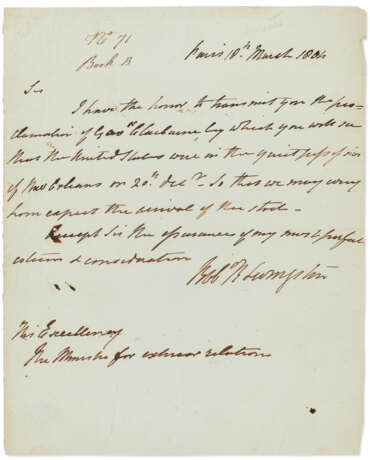ID 1362359
Lot 658 | Finalizing the Louisiana Purchase
Valeur estimée
$ 8 000 – 12 000
Robert R. Livingston, 18 March 1804
LOUISIANA PURCHASE — LIVINGSTON, Robert R. (1746-1803). Autograph letter signed ("Rob R. Livingston") as United States Minister to France to [Charles Maurice de Talleyrand ("The Minister of external relations")], Paris, 18 March 1804.
One page 239 x 192mm (mild dustsoiling, marginal wear and mounting remnants at upper and lower margins).
Robert Livingston's retained copy of his report to Talleyrand on the successful handover of New Orleans to the United States and the imminent arrival of bonds to pay for the Louisiana Purchase. "I have the honor to transmit you the Proclamation of Gov. Claibourne, by which you will see that the United States were in the quiet possession of New Orleans on 20th decr” Livingston, who with James Madison, negotiated the purchase of the Louisiana Territory from France in 1803, was enclosing William C. C. Claiborne's trilingual proclamation of 10 December 1803 [not present], "to declare that the government heretofore exercised over the said Province of Louisiana, as well as the authority of Spain as of the French republic, has ceased, and that of the United Sates of America is established over the same…."
Paying for the Louisiana Purchase. a Livingston then reassures Talleyrand, that since a document dated in early December had arrived then, it followed “that we may very hour expect the arrival of the stock.” Madison was referring to the 60 million franc in bonds issued by the United States to fund the Louisiana Purchase. Because the bonds would not begin maturation until 1819, Napoleon sold the the bonds to Barings and Hopes for a discounted 52 million franc. Barings agreed to pay the French government in installments beginning with a 6 million franc down payment to be followed by 23 monthly installments of 2 million francs. The United States issued the first bonds on 16 January 1804, but Livingston was under pressure from Talleyrand as the banks had already advanced France 10 million franc, and Napoleon was impatient for those bonds to be delivered so he repay that debt. Three weeks after Livingston had assured Talleyrand of the imminent arrival of the stock, they had yet to arrive and he complained to President Thomas Jefferson: “Your messenger with the Stock has not yet arrived, tho’ he is impatiently expected, as the house of Hope have their agent here who wishes to make arrangements for money of the French Treasury[.] This Government are also anxious to have anticipated the first third of the bills I have delivered, & Shall be very happy when the whole Shall be out of my hands.” (RL to TJ, 14 April 1804, Madison Papers). The first installment of bonds was to have been carried by Lewis Harvie, Jefferson’s secretary, but instead they came via Lt. James T. Leonard of the Navy, who finally arrived in Paris on 25 April. Livingston reported the same to Jefferson on 3 May rejoicing that “Nothing could be more happy than the arrival of the Stock—its delay had occasioned great anxiety, as the Bankers were on the Spot ready to take up their bills which the present State of things made the Treasury very anxious to turn into money. I have happily got rid of this very burdensome deposit…” (Madison Papers)
| Catégorie: | Services |
|---|---|
| Catégorie maison de vente aux enchères: | Livres et manuscrits |
| Catégorie: | Services |
|---|---|
| Catégorie maison de vente aux enchères: | Livres et manuscrits |
| Adresse de l'enchère |
CHRISTIE'S 20 Rockefeller Plaza 10020 New York Etats-Unis | ||||||||||||||
|---|---|---|---|---|---|---|---|---|---|---|---|---|---|---|---|
| Aperçu |
| ||||||||||||||
| Téléphone | +1 212 636 2000 | ||||||||||||||
| Fax | +1 212 636 4930 | ||||||||||||||
| Conditions d'utilisation | Conditions d'utilisation | ||||||||||||||
| transport |
Service postal Service de messagerie ramassage par vous-même | ||||||||||||||
| Modes de paiement |
Virement bancaire | ||||||||||||||
| Heures d'ouverture | Heures d'ouverture
|



